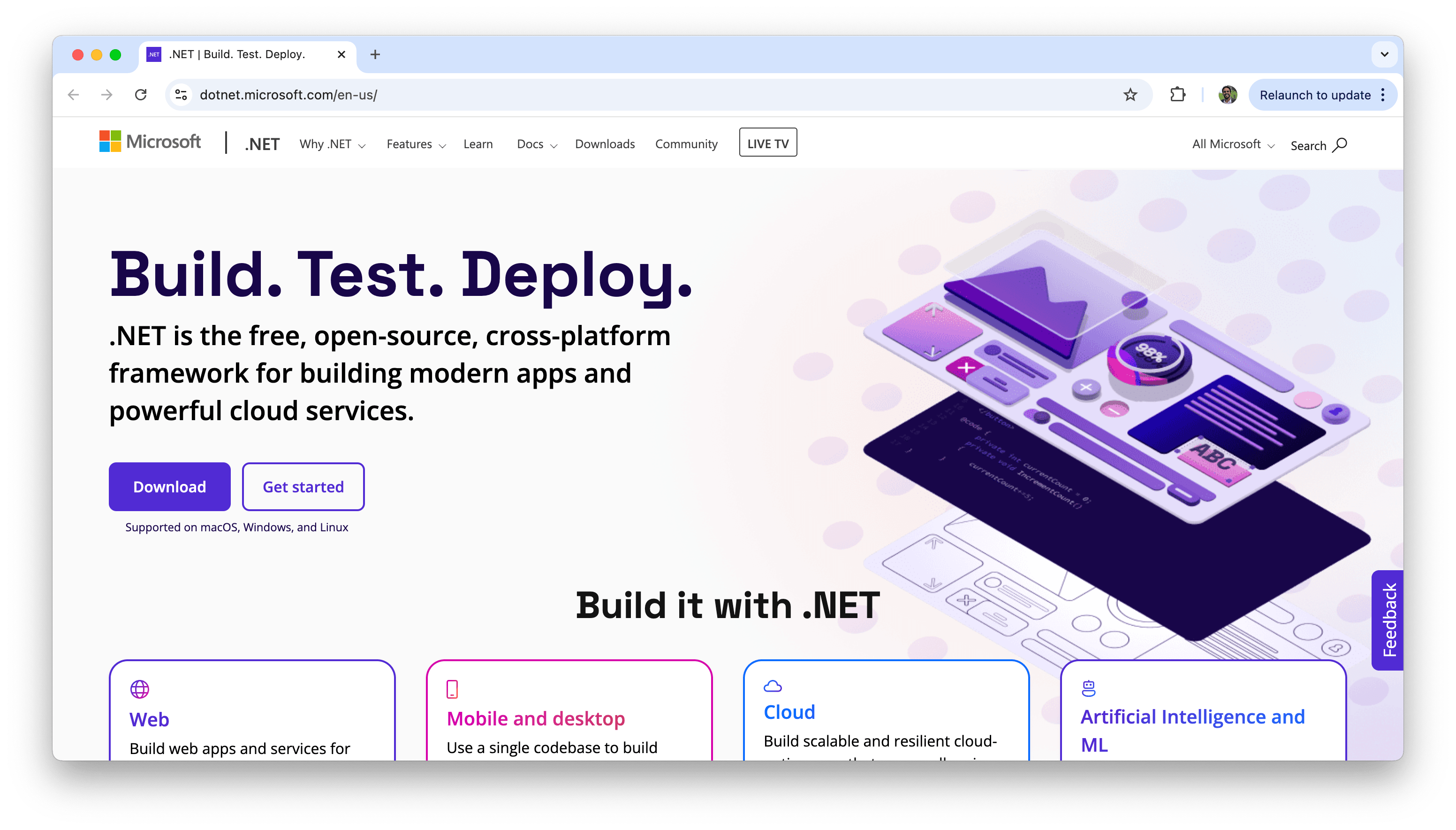Comparing WebForms, MVC, ASP.NET Core and React/Next.js—Which Technology Fits Your Needs?

Explore the differences, benefits and use cases of WebForms, MVC, ASP.NET Core and React/Next.js, so your team can select the right technology.
Choosing the right web framework can be an important decision that impacts development speed, performance and maintainability. Within the Microsoft .NET ecosystem, developers often decide between WebForms, MVC and ASP.NET Core, while JavaScript-based teams frequently consider React or Next.js for frontend development. Understanding the strengths and trade-offs of each option is essential for making an informed choice.
In this article, we’ll explore the core differences, benefits and use cases of these frameworks, helping you and your team select the right technology.
Microsoft .NET
Microsoft .NET is a powerful and versatile development platform for building web applications, desktop software, cloud services and more. Over the years, it has evolved from WebForms, a legacy framework focused on rapid UI development, to ASP.NET MVC, which introduced structured web development principles, and finally to ASP.NET Core, a modern, high-performance, cross-platform framework.
Each framework caters to different development needs, such as maintaining enterprise applications, building scalable cloud-native solutions or integrating frontend JavaScript technologies like React and Next.js for interactive user experiences.

In the following sections, we’ll compare WebForms, MVC, ASP.NET Core, React and Next.js, exploring their core differences and best-use scenarios to guide your technology selection.
Overview
WebForms
Best for: Maintaining legacy applications, rapid drag-and-drop development.
WebForms is an older, page-centric, event-driven framework in .NET that simplifies UI development with its drag-and-drop model. It uses ViewState to maintain UI state across postbacks but has performance drawbacks due to its tightly coupled architecture. While WebForms is still used in legacy enterprise applications, it lacks the flexibility and scalability required for modern web applications.
MVC
Best for: Structured enterprise applications with a clear separation of concerns.
ASP.NET MVC follows the Model-View-Controller (MVC) architecture, enabling better separation between data handling, UI rendering and user interactions. Unlike WebForms, MVC gives developers complete control over HTML output and eliminates ViewState, improving performance and flexibility. It is well-suited for SEO-friendly applications and large-scale projects requiring well-defined architecture. However, it does not offer the same cross-platform support as ASP.NET Core.
ASP.NET Core
Best for: Modern, high-performance, cloud-native and cross-platform applications.
ASP.NET Core is a lightweight, modular, cross-platform framework for modern web development. It offers high performance, cloud-native capabilities and integration with microservices and containerized architectures. Supporting deployment across Windows, Linux and macOS, ASP.NET Core is often the preferred choice for organizations building scalable and high-availability applications.
React/Next.js
Best for: Interactive, dynamic frontend applications, SEO-driven websites.
React is a popular JavaScript library focused on component-based UI development. It excels in dynamic and interactive web applications requiring frequent UI updates, such as dashboards and real-time interfaces.
Next.js, built on React, extends its capabilities by adding server-side rendering (SSR) and static site ceneration (SSG), making it an excellent choice for SEO-optimized applications. It also provides API routes, allowing teams to build full-stack JavaScript applications without requiring a separate backend.
What to Keep in Mind for Backend Developers
WebForms, MVC and ASP.NET Core rely on the .NET ecosystem, C# and Visual Studio for development. In contrast, React and Next.js primarily use JavaScript or TypeScript, with Node.js powering the backend in Next.js applications.
Deployment environments vary across these technologies. WebForms and MVC are typically hosted on Windows servers running IIS. ASP.NET Core, in contrast, supports cross-platform hosting and can be deployed on Windows, Linux, macOS, Docker and even serverless environments such as Azure Functions. Next.js applications run on Node.js-based hosting platforms, including Vercel, AWS and Docker-based setups.
Performance considerations also play a key role in choosing the right framework. WebForms applications tend to have higher overhead due to ViewState management. MVC improves upon this by offering a more streamlined execution model. ASP.NET Core is known for its high performance, low memory footprint and ability to scale efficiently. Next.js performance is heavily influenced by the chosen rendering strategy, whether server-side rendering, static generation or client-side rendering.
Why Modern Development Favors ASP.NET Core and React/Next.js
WebForms, once a go-to framework for rapid UI development, is now primarily suited for maintaining existing applications rather than starting new ones. MVC improved upon this by introducing structured, testable architectures, making it a stepping stone toward more modern solutions.
ASP.NET Core represents the future of .NET web development, delivering high performance, modularity and cross-platform capabilities. It integrates neatly with microservices, cloud platforms and modern security practices, making it the most viable option for new .NET-based projects.
React and Next.js take web development beyond .NET, providing a JavaScript-centric stack ideal for building dynamic, interactive frontend experiences. Next.js enhances performance with server-side rendering and static site generation, making it a strong contender for SEO-focused applications.
For teams already invested in .NET, ASP.NET Core is the logical next step for modernization. Meanwhile, organizations focused on frontend-heavy applications or with a JavaScript-savvy team may find React and Next.js a better fit.
Sitefinity: A Content Management Perspective
Progress Sitefinity is a robust content management system (CMS) designed to simplify website development while allowing for sophisticated digital experiences. From intuitive tools for marketers to flexible, extensible capabilities for developers, Progress Sitefinity CMS brings everything needed to craft engaging online experiences. It serves as a foundation for building connected digital experience platforms (DXPs) that support cloud deployment, personalization and content management.

While every framework discussed in this article has unique strengths, Sitefinity extends many of these technologies with its content management features and flexible architecture.
Older Sitefinity projects might still rely on WebForms, but Sitefinity support for Webforms capabilities is limited to v13.3 LTS, which is in the Sunset phase, to be retired in April 2026. Webforms capabilities are no longer eligible for support or bug fixes in projects using v14.1 or higher, and expected Webforms widget functionality is not guaranteed.
As the successor to WebForms, MVC will be supported through the Sitefinity 15 line. However, for future-proofing plans, the Progress Sitefinity team strongly recommends existing projects to plan a transition to ASP.NET Core or Next.js, and for new projects to be planned on one of these more modern technologies.
The upside is that users transitioning from WebForms or MVC can boost efficiency and development speed with the out-of-the-box features in the content editor and a large library of prebuilt and easily customizable widgets available in both the Next.js and ASP.NET Core Renderers. (For more information and help in planning a transition from WebForms or MVC to ASP.NET Core or Next.js, visit the migration analysis guide on GitHub or the Upgrade 101 section on the Progress website.)
With hybrid headless capabilities, Sitefinity exposes APIs that allow developers to integrate with JavaScript frameworks like React and Next.js, providing flexible frontend development while keeping .NET on the backend.
Whether maintaining an existing Sitefinity project or transitioning to a decoupled setup, the platform provides scalable options that align with your technology stack. Those looking for a fully integrated .NET solution can rely on the ASP.NET Core renderer with built-in widgets.
Teams aiming for the flexibility to develop cross-platform applications can utilize Sitefinity SaaS with the Next.js renderer on the frontend. This approach offers the added advantage of integrated hosting for the frontend application. Consequently, teams can work on their preferred machines and employ their chosen JavaScript technology without requiring expertise in .NET Core.
Teams requiring full frontend flexibility can adopt a hybrid-headless Sitefinity approach, with APIs opening up the technology options—Vue, React, Angular, you name it, you have full flexibility to build anything from scratch.
Wrap-up
Selecting the right framework depends on your project’s needs and the team’s expertise. WebForms paved the way for now-legacy applications, but ASP.NET Core is the modern, scalable choice for .NET development. React and Next.js provide robust frontend solutions, especially with a headless CMS like Sitefinity, for flexible content management.
For .NET-focused teams, ASP.NET Core offers long-term stability and performance. Those prioritizing a JavaScript-first approach will benefit from React and Next.js. Understanding these trade-offs will help you maintain applications that are modern, scalable and adaptable to future needs.

Hassan Djirdeh
Hassan is a senior front-end engineer and has helped build large production applications at-scale at organizations like Doordash, Instacart, and Shopify. Hassan is also a published author and course instructor where he’s helped thousands of students learn in-depth front-end engineering skills like React, Vue, TypeScript, and GraphQL.
